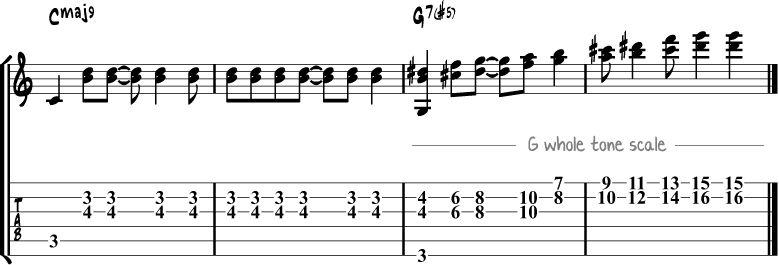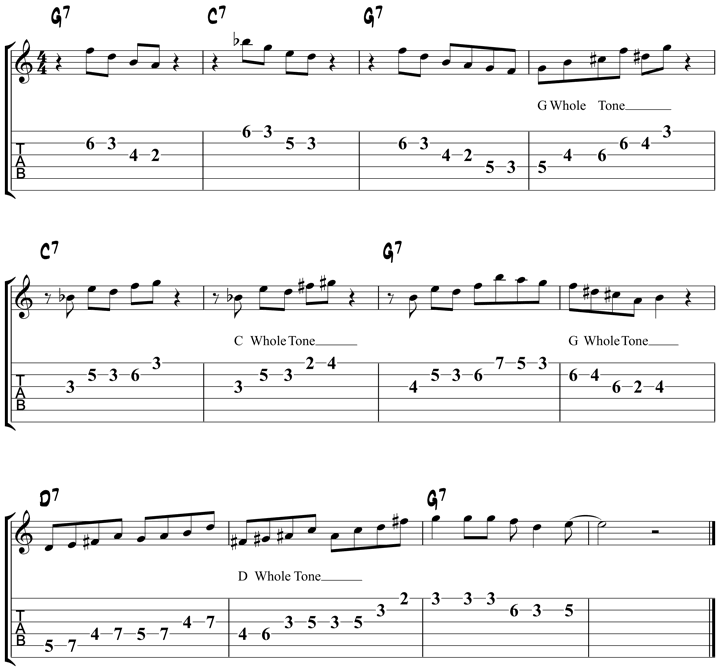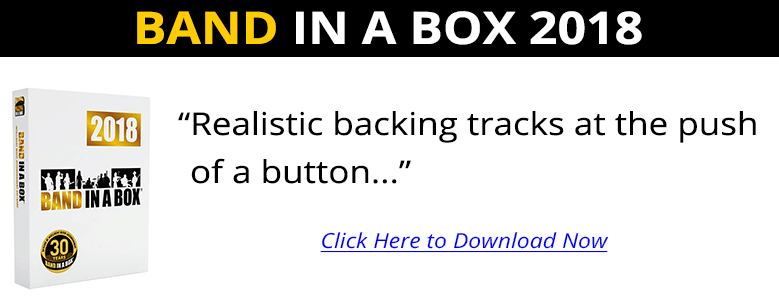The whole tone scale is often one of the first symmetrical scales that many guitarists explore in their studies and is a cool-sounding dominant 7th scale that you can use to add tension to your 7th chords.
The whole tone scale is a symmetrical scale with only one interval between each note: the whole step.
When doing so, you form a scale that contains the 3rd, #11, #5 and b7 intervals (among others), which is why you can apply this scale to any 7#5 chord in your playing, or to any dominant 7th chord when you want to bring a #11 and #5 sound to that chord change.
Use the whole tone scale to play over dominant augmented chords (G whole tone scale over G7#5 for example).
In this lesson, you will learn how to build and apply the whole tone scale to your jazz guitar playing. You will learn how to play various fingerings for this scale, apply scale patterns, learn common whole tone scale licks, and a sample blues solo that uses this scale in its construction.
What Is The Whole Tone Scale?
The whole tone scale is a six-note symmetrical scale, which is built by starting on the tonic note, then moving up in whole steps until you reach the next tonic note, 6 notes away.
The whole tone scale is a hexatonic scale, which means it contains 6 notes.
To help you visualize how the whole tone scale is constructed, here is a layout of the interval structure:
| G Whole Tone Scale | G | A | B | C# | D# | F |
|---|---|---|---|---|---|---|
| Formula | 1 | 9 | 3 | #11 | #5 | b7 |
The Whole Tone Scale in Songs and Jazz Standards
The first known time the whole tone scale was used in a composition was in 1662 by Johann Rudolf Ahle. Since then it has been used often in classical music by composers such as Bach, Mozart, Berlioz, and Schubert. Impressionist composers such as Claude Debussy were quite fond of the scale and used it often in their compositions.
The most famous use of the whole tone scale in popular music is in the intro of Stevie Wonder’s You Are The Sunshine Of My Life.
Here are the guitar tabs for the intro, the whole tone scale is used on the G7 in bars 3 and 4:

A famous example in jazz music is the intro of McCoy Tyner on Wayne Shorter’s jazz standard Juju:

Other jazz standards featuring the whole tone scale are One Down, One Up (John Coltrane), and many of Thelonious Monk‘s compositions and solos, including Four in One and Trinkle-Tinkle.
As you can hear, the whole tone scale has a very distinctive sound that can easily be too much if used too often. The scale is great to add some variation to your dominant playing though, just use it sparingly.
Whole Tone Scale Fingerings
Armed with this theoretical knowledge of how to build and apply the whole tone scale, let’s move on to applying this scale to the fingerboard as you learn four common shapes for the whole tone scale.
Here is a G whole tone scale with the root note on the 6th string, moving up in position from that starting note.
Listen & Play Along

Moving on, here is an in-position C whole tone scale, starting on the 5th string and moving up in position from that tonic note.
Listen & Play Along

The next G whole tone scale begins on the 6th string and uses a shifting fingering to move up from that starting point. When doing so, you are playing 3 notes on each string, using the same shape on each string as you climb your way up the fretboard.
Listen & Play Along

The final scale in this section is a C whole tone scale that begins on the 5th string and uses a shifting fingering to move up the fretboard from there.
Listen & Play Along

Once you have worked out any of these whole tone scales, put on a backing track, starting with 7th chords or 7#5 chords before moving on to ii-V-I’s and other progressions, and practice soloing over those backing tracks.
Whole Tone Scale Practice Patterns
With the four whole tone scale fingerings under your belt, let’s look at four variations of a scale pattern that you can use in your practice to expand your technique and knowledge of the whole tone scale on the fretboard.
Each pattern is written ascending up the scale shape, but feel free to use them descending as well.
The first scale pattern features ascending 3rds up the scale. This means that you play the first note of the scale, followed by the 3rd note, then the 2nd note, followed by the 4th note, and so on.
Listen & Play Along

You will now reverse that pattern by applying descending 3rd intervals to your whole tone scale practice routine.
Listen & Play Along

In the next pattern, you will combine the first two patterns as you play up the first 3rd and down the second 3rd interval, continuing that alternating pattern throughout the scale.
Listen & Play Along

The final pattern features the reverse of the previous scale pattern, as now you are beginning with an ascending 3rd, followed by a descending third.
Listen & Play Along

As was the case with the scale fingerings, once you have any of these scale patterns under your fingers, put on a backing track and begin to solo over 7th and 7#5 chords using the patterns from this section to build your improvised lines and phrases.
Whole Tone Scale Triads
When you build triads on each note of the whole tone scale, all of them are augmented triads:
| G aug | G | B | D# |
| 1 | 3 | #5 | |
| A aug | A | C# | E# |
| 1 | 3 | #5 | |
| B aug | B | D# | F## |
| 1 | 3 | #5 | |
| C# aug | C# | E# | G## |
| 1 | 3 | #5 | |
| D# aug | D# | F## | A## |
| 1 | 3 | #5 | |
| F aug | F | A | C# |
| 1 | 3 | #5 |
This means you can start by playing a G augmented triad over G7#5 and go up or down the guitar neck every 2 frets, such as in this example:

Whole Tone Scale Licks
Now that you have learned four fingerings for the whole tone scale, and four different scale patterns to work with those fingerings, let’s move on to studying this scale in a musical situation by working out the three jazz guitar licks below.
The first lick uses the G whole tone scale to solo over a G7#5 chord, the most direct application of this scale in a soloing situation.
Listen & Play Along

The second lick uses the G whole tone scale over a G7 chord in a short ii-V-I progression in the key of C major, bringing a 7#5 sound to that part of the progression.
Listen & Play Along

The final lick in this section uses the G whole tone scale over the V7 chord as well as the VI7alt chord in a ii-V-I-VI progression in the key of C major.
Listen & Play Along

After learning these three sample licks, try writing out a few licks of your own over these, and other, chord progressions using the whole tone scale to outline each 7th chord in those progressions.
Whole Tone Scale Blues Solo
To finish your introduction to the whole tone scale, here is a sample solo written over a blues progression in the key of G.
Each four-bar section of the solo is written as a stand-alone phrase, so feel free to learn the solo one phrase at a time and then bring all 3 phrases together after that.
Listen & Play Along

More Guitar Scale Lessons



How do you progress chords of the whole time scale to each other …..the music theory
Thanks, great presentation!